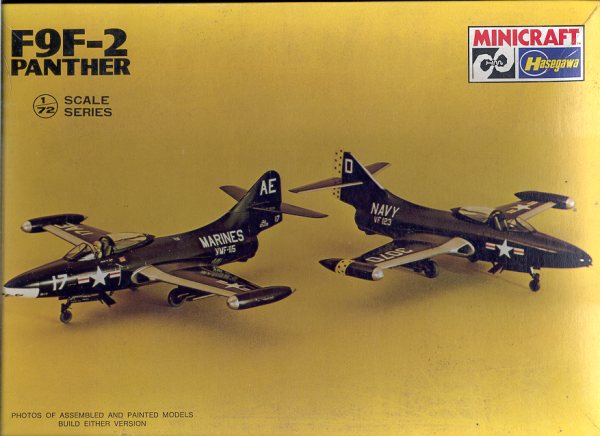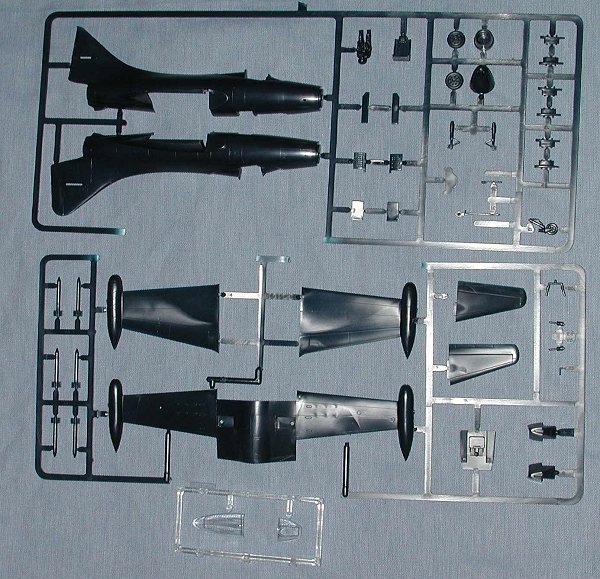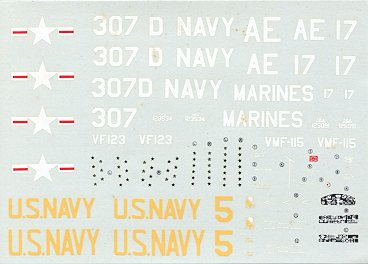
| KIT: | Minicraft/Hasegawa 1/72 F9F-2 Panther |
| KIT # | 1138 |
| PRICE: | $4.95 back in 1984 |
| DECALS: | Three aircraft |
| REVIEW & | |
| NOTES: | ` |

| HISTORY |
After the Banshee, the F9F Panther was the Navy's next successful jet fighter. Like the Banshee, it was a very conservative design, still with straight wings to allow it to have a slow enough landing speed for the days straight deck carriers. A change from the F2H was the single engine. Most Navy pilots preferred having a second engine when it came to jets, a trait that is still seen in Naval aircraft of today. However, jet engine technology had gained such that the engines were much more reliable and the extra weight wasn't needed to get good performance.
The Panther was blooded in Korea and while an air to air kill or two was obtained by the F9F, it was with ground attack that the plane made its mark. The combination of rockets or bombs and the nose guns were perfect for shooting up troops, trucks or trains. The type was also featured in an excellent movie 'The Bridges at Toko-Ri'. It is a super movie for modelers to use as a reference as well. Eventually the Panther was replace by the Cougar and other swept wing types.
| THE KIT |

This is a second generation Hasegawa kit from the mid 1980s. Like most other Hasegawa kits brought into the US at that time, it was reboxed by Minicraft, as much to conform to truth in advertising laws as anything else. This law was taken quite literally by most kit makers and the lovely box art disappeared from shelves to be replaced by photos of built up kits. Fortunately, it only lasted about a decade so we are back to nice box art on the top with built-ups shown on the side.
Anyway, this kit is typical of many of today's 1/72 Hasegawa releases. It has a nice cockpit tub with seat, stick and instrument panel. Instruments are given as decals. There are really few options on this one. You have your choice of clean wing or rockets, open or closed canopy, and open or closed speed brakes. That is about it. The wheel wells are lacking detail as are the brake  wells, but there is precious little to see in there anyway as the kit is molded with the inner gear doors closed. What makes this a second generation kit as opposed to the third generation types you now see is the lack of subassemblies to do different types. This makes for a pretty straight-forward build with minimum muss and fuss. Indeed, this kit really has few parts compared to many modern kits and that is part of its appeal.
wells, but there is precious little to see in there anyway as the kit is molded with the inner gear doors closed. What makes this a second generation kit as opposed to the third generation types you now see is the lack of subassemblies to do different types. This makes for a pretty straight-forward build with minimum muss and fuss. Indeed, this kit really has few parts compared to many modern kits and that is part of its appeal.
The instructions are more than adequate, showing construction in 6 steps. There is no interior painting information so you are on your own regarding that. Decals are the same as the normal Hasegawa kit and offer markings for three aircraft. One is from VF-123 with yellow wing tip and rudder markings. Next is a VMF-115 plane which is shown on the box top along with the VF-123 plane. Finally a Blue Angels aircraft. The Scalemaster decal sheet is generally superior to the Hasegawa kit decals, however, even back 15 or more years ago, registration was a problem as the red is off register enough to make those decals unusable.
| CONCLUSIONS |
A very nice kit that many of us have built over the years. It is one that I can heartily recommend to all but the bare beginner.
Review kit courtesy of me and my wallet!
If you would like your product reviewed fairly and quickly by asite that averages thousands of visits a day, please contactme or see other details in the